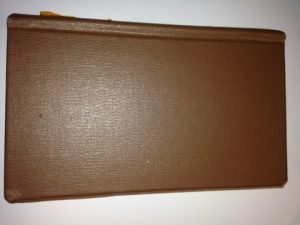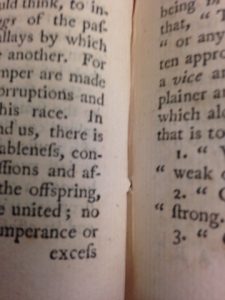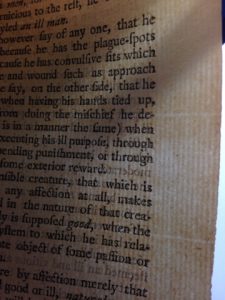Upon meeting with the archivists of the University of Virginia’s College at Wise, I learned many interesting things. One being that there is a long journey ahead of me. With… Read More
Upon meeting with the archivists of the University of Virginia’s College at Wise, I learned many interesting things. One being that there is a long journey ahead of me. With all the resources that are available, you can imagine that beginning an archival based research project on the history of the social life of books of Appalachia is like confronting the Leviathan. However, being the proud Appalachian that I am, I am ecstatic to embark on this journey and further connect myself with the history of what I am honored to call home. The Appalachian Mountains, being one of the oldest mountain ranges on the planet, has an extremely deep and rich culture and history.
It came to my knowledge through the help of our archivists that the oldest book in our library the philosophical work known as
Characteristicks of Men, Manners, Opinions, Times by Anthony Ashley Cooper, Earl of Shaftesbury. This work was first published in 1714 (Volume III), although the copy I have in my hands is a reprinted version from 1958 that was printed by J. Baskerville in Birmingham, Alabama. According to our senior archivist, the owner of this set before it came into the hands of the college is unknown. As far as the history of this work goes, it turns out that Cooper, the grandson of the first earl, was an English politician with a taste for neoplatonic derived philosophy as is revealed in this book (The Editors of Encyclopædia Britannica). It is thought that this famous 18th century philosopher and student of John Locke created this exploration of moral sense in response to another great philosopher of the same time, Thomas Hobbes (McAteer). According to McAteer, through the style of writing of Anthony Ashley Cooper, it can be felt that this book had intentions of affecting the readers moral sense in a positive way rather than simple speculation (McAteer).
On another note, a specific collection in our library that I am particularly interested in exploring is the James Taylor Adams collection. James Taylor Adams was a faithful patron to the Appalachian literary world. A jack of all trades, Adams served and worked as a writer, newspaper editor, historian, Post Master, and merchant. He lived in an area known as Stephens of Wise, Virginia. Adams diligently created a collection of Appalachian folklore and folk songs along with historical records of Wise County. There are also many works of local genealogy in the collection. The college came by this wonderful collection of local history over forty years ago through the gracious donation of the Adams family after the passing of James Taylor Adams.
Bailey Curtlan Helbert
The University of Virginia’s College at Wise, 2017
Department of Natural Sciences
Biochemistry
The Editors of Encyclopædia Britannica. “Anthony Ashley Cooper, 3rd Earl of Shaftesbury | English Politician and Philosopher [1671-1713].” Encyclopædia Britannica, Encyclopædia Britannica, 9 Feb. 2007, https://www.britannica.com/biography/Anthony-Ashley-Cooper-3rd-Earl-of-Shaftesbury#ref184884. Accessed 18 Jan. 2017.
McAteer, John. “The Third Earl of Shaftesbury (1671—1713).”
Internet Encyclopedia of Philosophy, http://www.iep.utm.edu/shaftes/. Accessed 18 Jan. 2017.



